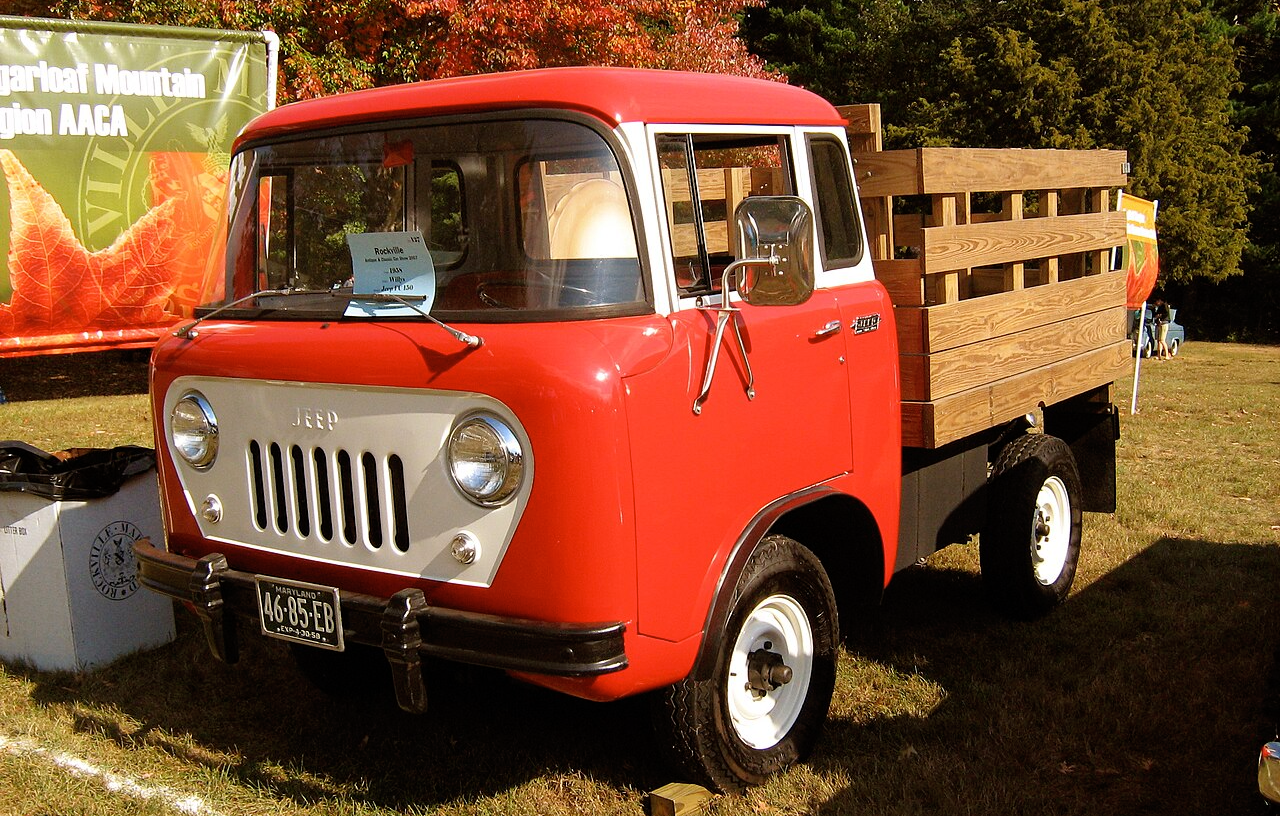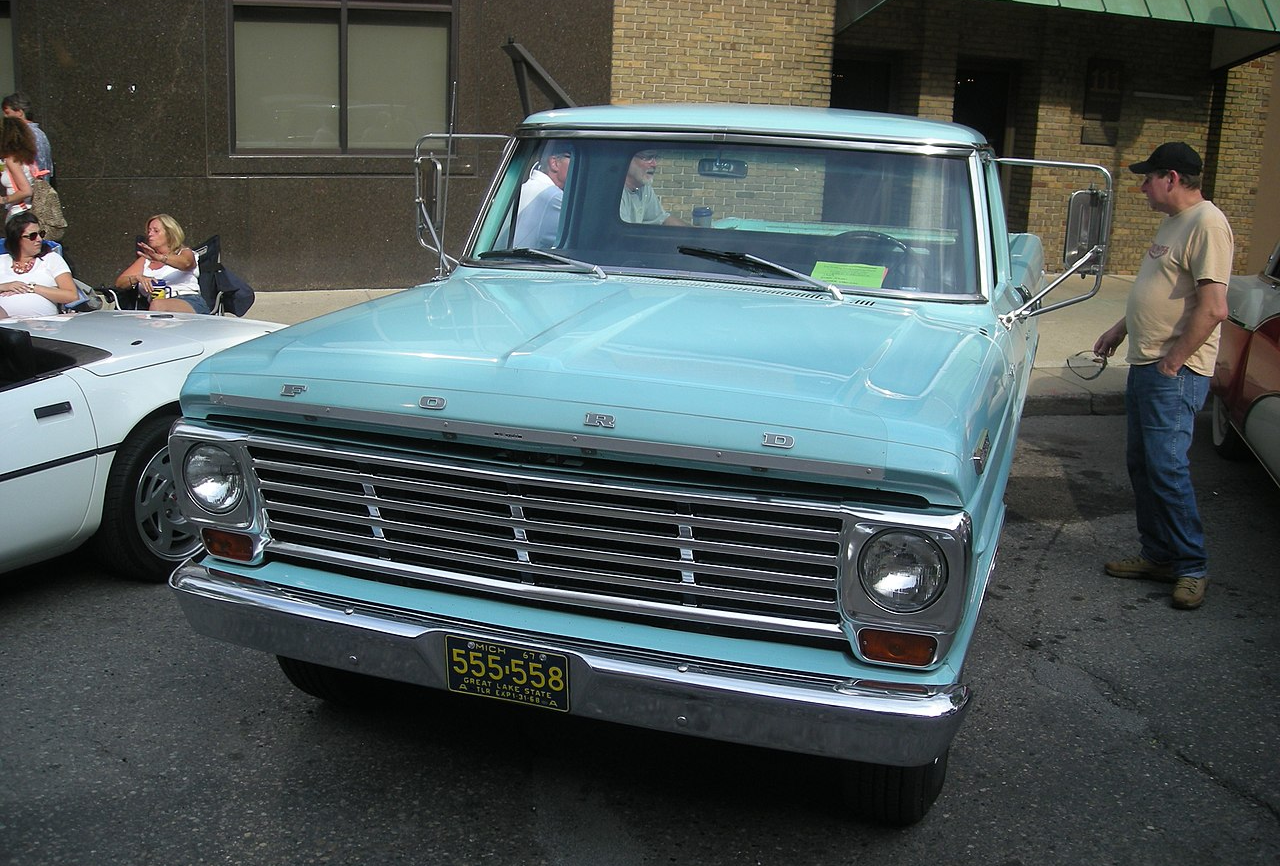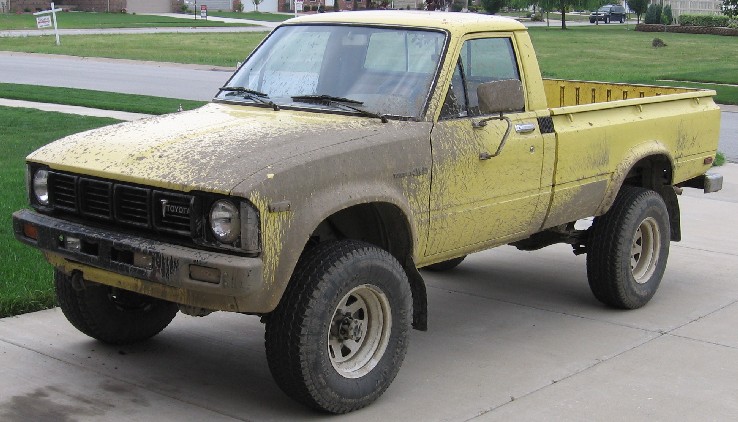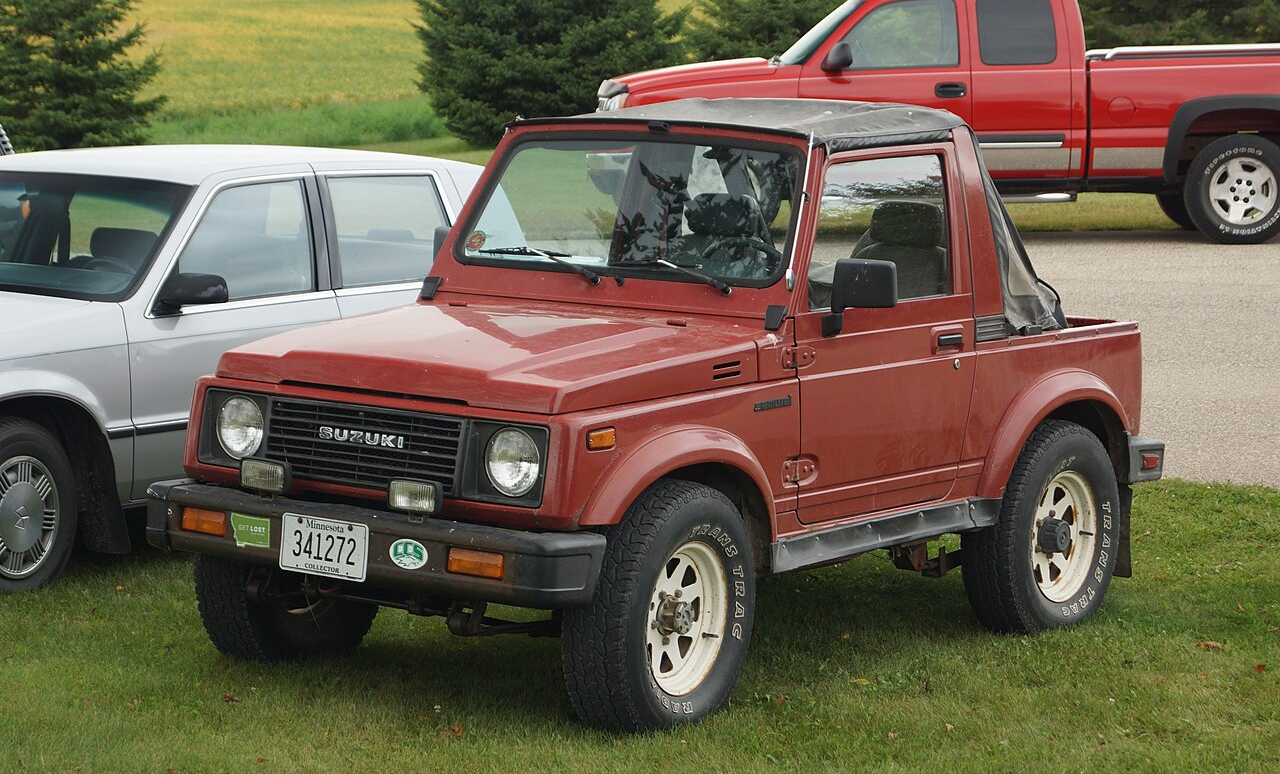Keep On Trucking!
Truck collectors pay big bucks to get their hands on vehicles remembered fondly for their quality, reliability, or just plain rarity. Let’s take a drive down memory lane to see what trucks are parked there—and maybe even on your driveway or in your garage!

Chevrolet Suburban (1935–The Present)
The Chevrolet Suburban has gone through an astonishing 12 generations, blazing the trail for SUVs and four-wheel drives. Originally called the “Carryall Suburban,” this lineup combines a station wagon’s spaciousness with the powertrain of a pickup truck, letting you “carry all” your passengers and gear.
 Gold Pony, CC BY-SA 4.0, Wikimedia Commons
Gold Pony, CC BY-SA 4.0, Wikimedia Commons
NAPCO Chevy And GMC Trucks (1942–1959)
Chevrolet and GMC trucks didn’t come with four-wheel drive, so the Northwest Auto Parts Company (NAPCO) stepped into the breach with their conversion kits. Eventually, the two auto manufacturers offered their own four-wheel drive pickups, catching up with Dodge, which had offered trucks with four-wheel drive since the 1940s.
Willys CJ-2A (1945–1949)
This is the “Jeep” that inspired the Jeep, with that same seven-slot grille. The CJ-2A’s engine only produced 60 horsepower, but powered a pretty light frame. With four-wheel drive and a wide 80-inch wheelbase, it could be a deftly maneuverable farm vehicle or even a snow plow, or great for taking a spin through hiking country.
 David Berry, CC BY 2.0, Wikimedia Commons
David Berry, CC BY 2.0, Wikimedia Commons
Dodge Power Wagon (1946–1968)
Like the Willy CJ-2A, the Dodge Power Wagon grew out of a WWII military vehicle, becoming the first civilian four-wheel drive truck sold in the US. Despite the name, the V6 engine wasn’t powerful, with just 94 horsepower and 230 cubic inches. But special gearing and massive tires made hauling 3,000 pounds a cinch.
 Greg Gjerdingen, CC BY 2.0, Wikimedia Commons
Greg Gjerdingen, CC BY 2.0, Wikimedia Commons
Mercedes-Benz Unimog (1947–The Present)
Developed in Germany after WWII, variations and iterations have turned a simple farm truck into a fleet of civilian and military models, some of which can haul 16,000 pounds and drive through nearly three feet of water. Attempts to tap into the US market failed, but if you find one, outback adventures may be in store!
 Qwerty242, CC BY-SA 3.0, Wikimedia Commons
Qwerty242, CC BY-SA 3.0, Wikimedia Commons
Ford F-100 (1953–1956)
Ford truck superfans might love the first generation, called the F1, but starting in 1953, Ford really got the design right with a wide windshield, an automatic transmission with integrated torque converter, and the F-100 nameplate. All in all, it just looked and felt a lot classier, and by 1956, the V8 engine even hit 180 horsepower.
 crudmucosa, CC BY 2.0, Wikimedia Commons
crudmucosa, CC BY 2.0, Wikimedia Commons
Jeep FC-150 (1957–1965)
How do you turn a Jeep-looking Jeep into a pickup truck with the same wheelbase? By putting the cab over the engine and providing excellent “Forward Control” (FC) maneuverability and view–just think of the off-roading possibilities! Sadly, aerodynamics and mechanics kept the top speed down around 65 mph.
 Christopher Ziemnowicz, CC BY-SA 3.0, Wikimedia Commons
Christopher Ziemnowicz, CC BY-SA 3.0, Wikimedia Commons
Toyota FJ-40 (1960–1983)
With restored models costing $100,000 or more, reliving fond memories of this long-missed pickup might cost you a pretty penny. It developed a reputation for doing what had to be done, eventually with the help of a high-torque inline-six engine attached to a sturdy drivetrain to show how a four-wheel drive could be done right.
 Jeremy, CC BY 2.0, Wikimedia Commons
Jeremy, CC BY 2.0, Wikimedia Commons
International Harvester Travelall (1961–1975)
Oddly, giving an SUV four proper doors took a while to achieve. The Travelall was the first to do so, while still doing the usual SUV trick of merging the space of a station wagon with the power of a pickup truck. Coming in two- and four-wheel drive versions, the Travelall’s stylish lines make it a favorite among collectors.
 dave_7, CC BY 2.0, Wikimedia Commons
dave_7, CC BY 2.0, Wikimedia Commons
Jeep Gladiator And J-Series Trucks (1963–1987)
Jeep’s Gladiator, later just called J-Series or Jeep trucks, got particularly wild in the 1970s, when the company turned these trucks into something more “car-like,” offering vivid decals and Levi’s interiors as “Honcho” options, and even a CB radio for its “10-4” model. Nonetheless, the basic look stayed the same.
 Christopher Ziemnowicz, CC BY-SA 4.0, Wikimedia Commons
Christopher Ziemnowicz, CC BY-SA 4.0, Wikimedia Commons
Jeep Wagoneer (1963–1991)
The Jeep Wagoneer, along with the Chevy Suburban, solidified our idea of what would become the modern SUV. Based on a Jeep Gladiator pickup, luxury trims included the Brougham, Limited, and Grand, though faux wood grain on the side panels would be standard in later years.
 Greg Gjerdingen, CC BY 2.0, Wikimedia Commons
Greg Gjerdingen, CC BY 2.0, Wikimedia Commons
Kaiser Jeep M715 (1967–1969)
Also based on the Jeep Gladiator, the M715 was a military vehicle with stronger axles and an ultra-low gear ratio, plus a Warner T-98 four-speed manual transmission, all to help it climb difficult terrain in a slow and steady fashion. A 231-cubic-inch overhead-cam inline-six motor even got it up to 55 mph on the road.
 Greg Gjerdingen, CC BY 2.0, Wikimedia Commons
Greg Gjerdingen, CC BY 2.0, Wikimedia Commons
Chevy And GMC Pickups (1967–1972)
GM lowered their trucks, making them easier to climb into, and raised their potential market. The top-of-the-line Custom Sport Truck offered the powerful torque of a 396-cubic-inch V8, helping to promote the idea of a “muscle truck”.
Ford F-250 “Highboy” (1967–Early 1977)
The “Highboy” looks tough and stands tall, sitting a few inches higher than 3/4-ton trucks from Ford’s competitors at the time. Partway through the 1977 model year, Ford did a redesign, lowering the F-250 in the process. Unsurprisingly, these became known as “Lowboys”.
 Michael Barera, CC BY-SA 4.0, Wikimedia Commons
Michael Barera, CC BY-SA 4.0, Wikimedia Commons
Ford Baja Bronco (1971–1975)
Ford Broncos from 1966 to 1977 look cool enough as a whole, but the coolest of the cool are the limited-edition Baja Broncos. Renowned trail driver Bill Stroppe produced around 500 to replicate his own racing pickups, right down to the paint jobs and customized space for larger back tires.
 Greg Gjerdingen, CC BY 2.0, Wikimedia Commons
Greg Gjerdingen, CC BY 2.0, Wikimedia Commons
International Scout II (1971–1980)
International Harvester had already established a solid name for itself with four-wheel drives such as the Scout 80 and 800, but the Scout II in the 1970s really established the company’s reputation with trail-friendly minimal overhang, a sturdy Dana 44 front axle, and disc brakes. Options included a 345-cubic-inch V8 engine.
 Greg Gjerdingen, CC BY 2.0, Wikimedia Commons
Greg Gjerdingen, CC BY 2.0, Wikimedia Commons
Datsun 620 (1972–1979)
Datsun cleared the path for compact trucks in the US starting in 1959. Its fourth-generation 620 model in 1972 looked great (love the winglets!), but added a long bed (great for surfers!) and, starting in 1977, a larger interior called the King Cab. The 620 helped form our image of the California surfing scene.
 AN Shackle, CC BY-SA 4.0, Wikimedia Commons
AN Shackle, CC BY-SA 4.0, Wikimedia Commons
Chevy Blazer Chalet (1976–1977)
The Chevy Blazer was certainly a trail blazer, most particularly the Chalet model, with its Chinook camper nestled into the pickup bed. After a hard day driving down some challenging trails, you and a companion could camp in your own special Chalet–if you managed to get ahold of one of the 2,000 that were made.
Dodge Power Wagon Top Hand (1978)
The Top Hand was the rarest offering of Dodge’s innovative program of the 1970s, for which off-roader Vic Hickey added an impressive array of brush guards, roll bars, and other accessories to Dodge and other trucks. Less than 500 of these trucks were produced.
 NESR, CC BY-SA 2.0, Wikimedia Commons
NESR, CC BY-SA 2.0, Wikimedia Commons
Dodge Lil’ Red Express Truck (1978–1979)
Another of Dodge’s special offerings, this beauty was a modification of Dodge’s already powerful Express. Packing five horsepower and 35 lb-ft of torque more than a top-of-the-line Corvette meant it took the express route to reach 100 mph, faster than any other truck that year—or car, for that matter.
 Improbcat, CC BY-SA 3.0, Wikimedia Commons
Improbcat, CC BY-SA 3.0, Wikimedia Commons
Ford Bronco (1978–1980)
After Ford moved this SUV to an F-150 chassis, the Bronco became an attractive option for off-roading, while keeping the charm of the smaller first-generation version. You could even get a 460-cubic-inch engine. Sadly, in 1981, Ford replaced the Dana 44 solid front axle, making it less backwoods friendly.
 dave_7, CC BY 2.0, Wikimedia Commons
dave_7, CC BY 2.0, Wikimedia Commons
Toyota Hilux Pickup (1979–85)
Following Datsun’s pioneering efforts in the US marketplace, Toyota took to the passing lane, being the first to add four-wheel drive to a compact truck, and riding high enough with its durable drivetrain to make it an attractive off-roading option. The Hilux quickly became the compact truck to beat.
 BillD234, CC BY-SA 3.0, Wikimedia Commons
BillD234, CC BY-SA 3.0, Wikimedia Commons
Mercedes-Benz G-Wagen (1979–Present)
The Geländewagen started off as a military vehicle, but Mercedes-Benz’s hot rod experts at AMG turned it into an SUV with a powerful 563-horsepower engine, letting it accelerate from 0 to 60 mph in a little over five seconds.
 Alexander Migl, CC BY-SA 4.0, Wikimedia Commons
Alexander Migl, CC BY-SA 4.0, Wikimedia Commons
Jeep CJ-8 Scrambler (1981–1985)
Take a CJ-7 Jeep, add 10 inches to the wheelbase and attach a bedside that stretches the whole affair, and you have a Scrambler, which Jeep used to get into the increasingly lucrative small-truck market. It was a smoother ride than the CJ-7, and removable wooden stakes added to its cargo capacity.
 Mr.choppers, CC BY-SA 3.0, Wikimedia Commons
Mr.choppers, CC BY-SA 3.0, Wikimedia Commons
Toyota 4Runner (1984–1985)
Toyota took a four-wheel drive pickup and added better axles and suspensions at both ends, in addition to an extremely durable fuel-injected 22RE four-cylinder engine. Although great for off-roading, these modular-looking first-generation 4Runners look very different from modern SUVs.
 Mr.choppers, CC BY-SA 3.0, Wikimedia Commons
Mr.choppers, CC BY-SA 3.0, Wikimedia Commons
Jeep Cherokee (XJ) (1984–2001)
The Jeep Cherokee led the way in shrinking the SUV by using a “crossover” design more akin to a car. Instead of building on an underlying frame, XJs merged body and frame into a unibody.
Suzuki Samurai (1985–1995)
Punching above its weight class, the compact Samurai was designed with a solid chassis, sturdy axles, and leaf springs that supported larger tires. Sturdy and maneuverable with a short wheelbase, this four-wheel drive truck could get you places you just might think it wouldn’t.
 Greg Gjerdingen, CC BY 2.0, Wikimedia Commons
Greg Gjerdingen, CC BY 2.0, Wikimedia Commons
Lamborghini LM002 (1986–1993)
The “Rambo Lambo” had a powerful 450-horsepower V12 engine, but its 6,000-pound body meant this SUV accelerated from 0 to 60 mph in an unremarkable eight seconds. Nonetheless, it had a great four-wheel drive system, leather interior, and scarcity going for it, with fewer than 400 made.
 Detectandpreserve, CC BY-SA 3.0, Wikimedia Commons
Detectandpreserve, CC BY-SA 3.0, Wikimedia Commons
Nissan Hardbody 4x4 (Late 1986–1997)
The “Hardbody” compact truck had lots to show off, especially if you added the Sports package’s 31-inch tires and fender flares. The V4 and V6 versions of this 4x4 model are tremendously reliable, and still in use around the world, with the Nissan Pathfinder picking up on this design.
 Mr.choppers, CC BY-SA 2.0, Wikimedia Commons
Mr.choppers, CC BY-SA 2.0, Wikimedia Commons
Land Rover Range Rover (1987–1997)
The Range Rover shook up the high-end four-wheel drive market with a classy interior and long-travel axle suspension, great for off-roading. In the early 1990s, you could even upgrade to a 4.2-liter engine and a wider wheelbase. But collectors be warned: pretty they may be, but durable they are not.
 Jeremy, CC BY 2.0, Wikimedia Commons
Jeremy, CC BY 2.0, Wikimedia Commons
Chevy/GMC V3500 Crew Cab 4x4 (1988–1991)
GM alienated some of its tow truck and off-roading fans when it scaled up its light-duty pickups, but keeping the old crew cab and chassis turned the tide for many critics of the V3500.Fans of heavy trucks particularly liked the new model’s square-jawed look.
 order_242, CC BY-SA 2.0, Wikimedia Commons
order_242, CC BY-SA 2.0, Wikimedia Commons
Chevy And GMC GMT400 (1988–1998)
General Motors made the GMT400 thinner for the aerodynamics, while somehow giving it more space, along with an independent front suspension for easier steering and the ability to switch in and out of four-wheel drive no matter how fast you were going, making it an off-road delight.
 Mr.choppers, CC BY-SA 3.0, Wikimedia Commons
Mr.choppers, CC BY-SA 3.0, Wikimedia Commons
Dodge Shelby Dakota (1989)
Although not blindingly fast by today’s standards, the Shelby Dakota reignited the idea of a performance pickup truck when Carroll Shelby swapped a 3.9-liter V6 engine for a 5.2-liter V8, coupling 175 horsepower with a four-speed automatic transmission.
 Latvian98, CC BY-SA 3.0, Wikimedia Commons
Latvian98, CC BY-SA 3.0, Wikimedia Commons
W-250/350 Dodge Power Ram Cummins Turbo Diesel (1989–1993)
Late to the diesel party, Dodge took a six-cylinder Cummins diesel engine and plunked it into a heavy-duty truck. With such a powerful motor, drivers could haul more and Dodge’s competitors could fret about how to get more torque out of their own offerings.
 Mr.choppers, CC BY-SA 3.0, Wikimedia Commons
Mr.choppers, CC BY-SA 3.0, Wikimedia Commons
Rod Hall Signature Edition Dodge (1990)
With the help of Carroll Shelby, racer Rod Hall took Dodge Ram 150s and added pre-runner bumpers, a bed-mounted light bar, and special driving lights. Collectors would be lucky to get any of the 33 made, though drivers might lament that each 318-cubic-inch V8 engine managed just 170 horsepower.
 Elise240SX, CC BY-SA 4.0, Wikimedia Commons
Elise240SX, CC BY-SA 4.0, Wikimedia Commons
Chevy 454 SS (1990–1993)
Once again, we’ve got a big engine in a smaller truck. A heavy-duty pickup’s motor pushed the 1991 model to 255 horsepower and 405 lb-ft of torque, allowing this sports truck to reach 60 mph in around seven seconds, which put it somewhere near Camaro territory.
 Vauxford, CC BY-SA 4.0, Wikimedia Commons
Vauxford, CC BY-SA 4.0, Wikimedia Commons
GMC Syclone/Typhoon (1991–1993)
And here we have a similar approach: A 4.3-liter V6 engine that put out 280 horsepower and 360 lb-ft of torque was paired with all-wheel drive and Corvette’s automatic transmission, pushing the Syclone to 60 mph in 4.3 seconds. But there’s a downside to speed. It couldn’t carry much—and don’t even think about using it to tow.
 Greg Gjerdingen, CC BY 2.0, Wikimedia Commons
Greg Gjerdingen, CC BY 2.0, Wikimedia Commons
Dodge Ram SRT-10 (2004–2006)
Some 10,000 units of this beast were produced after Dodge and Plymouth Prowler engineers put the Viper’s V10 engine and six-speed manual transmission into a Ram 1500 and added some aerodynamic smoothing, pushing below the five-second mark when accelerating to 60 mph.
 Steve, CC BY 2.0, Wikimedia Commons
Steve, CC BY 2.0, Wikimedia Commons
Accelerating Progress
Collectors and fans of trucks value everything from pleasing aesthetics to faster speed, whether these vehicles are caught in highway traffic or roaming through the hills and vales of distant landscapes—or maybe just sitting pretty in your garage. At least one can dream.












